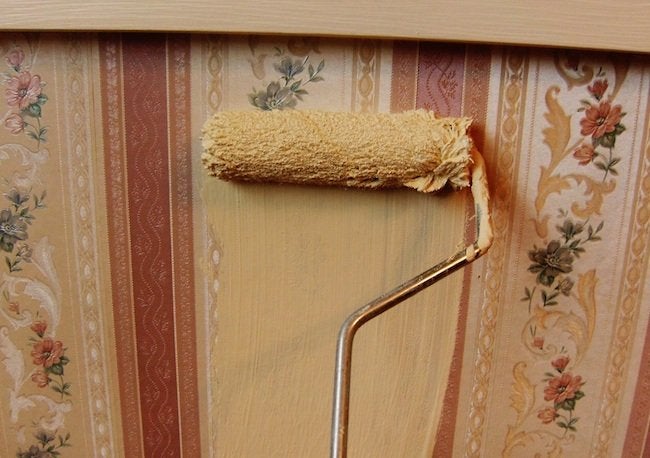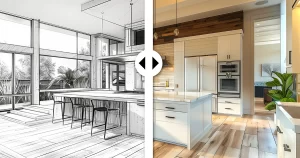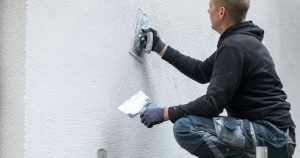This Is How You And Painting Contractors In Honolulu, Hawaii, Can Get The Best Results When Painting Over Wallpaper

In this post, you can find out if you can paint over wallpaper, what to do before you begin, the pros and cons, safety considerations, tools and materials, and then how to paint over wallpaper.
What DIYers Need To Know
- Beginner skill level
- About 6 to 10 hours per room
- $100 to $300
Is It Possible To Paint Over Wallpaper Or Not?
Yes, you can paint over wallpaper!
It’s way easier and less time-consuming than removing it, taking care of any scraps left on the wall, and then painting. If your wallpaper is in good condition or better, painting won’t be a problem.
Now, there are times when painting over wallpaper isn’t the best option.
With new construction homes, any wallpaper put up is done so without primer. Taking it down will severely damage the drywall. Then you have to repair damages and paint. It’ll make this home improvement project more expensive and time-consuming.
What To Do Before You Begin
You’ll want to do an assessment of the quality and condition of your wallpaper.
If you see it failing anywhere, such as peeling or lifting, you’ll want to know how to remove wallpaper. Painting over damaged wallpaper will make your walls look bad.
The Pros And Cons Of Painting Over Wallpaper
Pros
- You’ll save more time and money than if you take it off first
- Wallpaper painting is usually DIY-friendly
Cons
- You need to prepare the wall correctly so the wallpaper doesn’t peel, lift, or anything else
- Sometimes you can see the seams or texture from the wallpaper through the paint
- If the wallpaper is lower quality, it can look shabby
DIY Safety Considerations
While indoor painting is safer than many other home improvement projects, there are some safety precautions to keep in mind:
- Eye protection like safety glasses keeps paint and other chemicals out of your eyes
- Respirator masks keep paint fumes out of your lungs
- Sturdy ladders will keep you safe if you need to reach higher places
Tools And Materials
You’ll basically need the same tools and materials as if you were painting drywall.
Here’s what you’ll need when painting wallpaper:
- Gloves
- Eyewear
- Respirator mask
- Krud Kutter or another degreaser*
- Painting bucket
- Rags
- Drop cloths for your floors
- Painter’s tape
- Rollers or brushes
- Primer
- Paint
You may also need medium-fine sandpaper, a putty knife, and spackle for any repairs you may need to make.
*We recommend against using TSP (trisodium phosphate) for this project because it can do more harm than good
The Best Steps For Painting Over Wallpaper
1. Prepare your wallpaper for painting
You need to prep the surface or this whole home improvement project will be a waste of your time and money.
Dampen a rag with warm water and clean the dust, dirt, and grime off of your wallpaper. You may need to use a spray-on degreaser for anything harder to remove. Remember, TSP is for cleaning drywall, not wallpaper.
Lay down drop cloths to catch paint that drips or spills. A rag can help catch any paint trails made on your wallpaper.
2. Inspect your wallpaper’s edges
Unlike the quality check, you’ll be checking for damages that need fixing.
When painting over wallpaper, you don’t want to paint over damages or they’ll ruin the final look. You’ll want to inspect the edges for peeling, tearing, lifting, and any signs of wear and tear. If you find anything, you should be able to fix it with your spackle and putty knife (just like with normal drywall.
We recommend sanding any textured areas smooth, it’ll help the paint bond better.
3. Tape off the area
You don’t want paint going where it shouldn’t be, right?
Painter’s tape can help with that! Tape off molding, trim, windows, doors, and anything else that doesn’t need painting during your home improvement project.
4. Prime your wallpaper
You’ll want to use an oil-based primer instead of a water-based primer when painting over wallpaper.
OIl-based primers will essentially seal the wallpaper to the wall, making it a better surface for the paint. Water-based primers can make your wallpaper peel.
Follow the instructions on the primer for how long to wait until you begin painting.
5. Paint your wallpaper
You’ll need some patience with this step.
Painting wallpaper takes time, mainly because the paint needs to dry, and you need to apply multiple coats. It usually takes two coats of paint to keep the wallpaper from showing through the paint.
Once it dries, inspect it from different angles and in different lighting to ensure it looks exactly how you want it to look.
When Is Calling A Professional Painter The Best Option?
While painting over your wallpaper may seem easy, sometimes you need a pro to help.
If your wallpaper is failing, the prep work takes more time and knowledge. A painter can take care of this more quickly than your standard DIYer.
If your wallpaper has seams, painters can hide them better because they know how to do it best. It’ll take trial and error for a DIYer to figure out how.
If your wallpaper is low-quality, a professional painter can strip it off and paint it faster and more efficiently than a DIYer.
Painting Over Wallpaper
You can DIY your wallpaper painting project, but it’ll take time and effort you may not have. Anyways, shouldn’t weekends be for enjoying yourself instead of doing home improvement work?
You can use our contact form to tell us about your painting project. Or, you can look at our interior painting page for more information first.
Check Out Some Of Our Recent Posts

How AI & Smart Paint Technology Are Changing Home Painting in 2025
Imagine this: you’re planning to repaint your living room. Instead of browsing through dozens of paint samples or second-guessing the final look, an AI app

Bamboo, Lava Rock & Stucco: Painting Hawaii’s Unique Home Exteriors
If you’ve ever looked at your Hawaii home and thought, “How the heck do I paint this?”, you’re not alone. Living in paradise comes with its

Why Commercial Buildings in Honolulu Need Special Paint Coatings
Living in Honolulu has its perks: gorgeous beaches, year-round sunshine, and stunning ocean views. But if you own or manage a commercial property here, you
